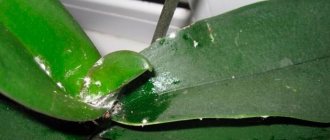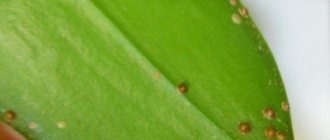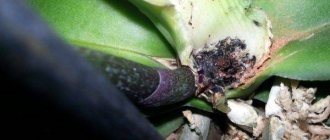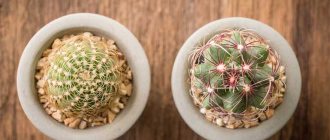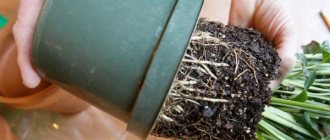Pests on indoor plants are always a nuisance and additional trouble for the gardener. Spider mites on an orchid are a special problem, because the pest arthropod is very small in size, and it is very difficult to notice it without a magnifying glass. Sometimes it becomes clear about the presence of ticks after a significant increase in the colony of parasites, forming up to 20 generations per season under favorable conditions.
Causes of appearance and what are the dangers?
The appearance of a mite on an orchid can be caused by several factors:
- presence in ready-made soil purchased in a store;
- planting a flower in an untreated container;
- hitting the windowsill through a window with a gust of wind;
- low level of air humidity;
- incorrect watering regime or insufficient frequency;
- oversaturation of the soil with minerals and other useful elements as a result of too frequent fertilizing.
Ticks also enter the room on human clothing.
Where do spider mites come from?
Spider mites can affect not only orchids, but also other outdoor indoor plants. If small white spots and thin cobwebs are found on the leaves of a flower, then this problem must be corrected immediately, otherwise all the leaves will soon be covered with them and insects will become more noticeable.
Tick infection can occur in several cases:
- when purchasing new indoor plants;
- if the owners exchange exotic plant species;
- when the air in the room is dry.
Naturally, the possibility of accidental infection with spider mites cannot be ruled out. Often this parasite first begins to infect the axils of flowers or the base of the stem. In some cases, the mite can even develop on the walls of a pot, windowsill or window and after some time moves onto the plant. If orchids are on a windowsill, where the window is often open, then the pest can get in from the leaves of the trees.
For some time, the spider mite can “sleep”, that is, be in an inactive phase. When it feels a favorable external environment, including dry air, it begins to actively reproduce.
The consequences for orchids can be different and depend on how much the parasite damages the plant. In any case, the appearance of the flowers will leave much to be desired. The orchid becomes weaker as its cells are destroyed and the intensity of photosynthesis decreases.
Also, this flower will be open to viral and bacterial infection. If the plant is not treated, it will simply die soon. But this is not the worst that can happen. Spider mites can easily parasitize other flowers, which can lead to the death of the entire collection of house plants.
The spider mite itself can act as a carrier of viral diseases and gray rot spores.
Varieties: what they look like from the photo
There are several types of mites that attack orchids, each of them has its own distinctive characteristics.
Red spiderweb on leaves
Tetranychus cinnabarinus. This type of arthropod pest is considered the most dangerous due to its increased resistance to insecticides. A female mite can lay 6 to 7 eggs per day, and up to 150 eggs per month. The most favorable environment for the reproduction of red spider mites is an excess of nitrogen in the soil. Its distinctive features are the yellow, orange or red color of the body.
Most often, the pest settles on the outside of the leaf.
Armored
Oribatida mites. Externally, the oribatid mite resembles a small dark pea. On average, its size is 0.8 mm. Color can vary from dark brown to brown and black. Adult parasites and larvae live in the soil and feed on its constituent components.
When there is a deficiency of nutrients, orchid mites infect orchid leaves. Phalaenopsis are especially susceptible to attacks from these arthropods. Ideal conditions for pests to reproduce are high soil moisture and lack of drying.
White cobweb or false
Tetranychus urticae. The false or white spider mite gets its name from the white web it produces. Due to its very small size (0.25-0.3 mm), it is almost impossible to see this pest. Its presence on an orchid can be detected by the presence of cobwebs.
In advanced cases, spider mites form large colonies, the color of which varies from green to red. From the first days of its appearance, this type of parasite begins to actively destroy the orchid.
Onion root
Rhizoglyphus echinopus. Externally, root mites resemble small spiders. Pests have three pairs of legs, an oval body and sharp antennae. Their main feature is their high endurance, which allows them to remain without food for a long time; their main diet is underground parts of the plant and organic remains.
The distinctive features of bulb mites are a large body (1-1.5 mm) with a cloudy, glassy color.
The parasites are quite prolific: one female lays up to 300 white oval eggs. Favorable living conditions for them are abundantly moist soil with excess fertilizer content. In the process of their life activity, these arthropods turn the orchid roots into dust, which leads to the death of the plant.
Flat-bodied
Tenuipalpidae. Flat-bodied mites are distinguished by their small size (up to 0.3 mm) and an oval, slightly flattened yellow-red body covered with miniature bristles. The presence of these pests can be detected only after the formation of colonies or by the affected plant fragments.
Symptoms of the lesion
Since the mite is small, it can only be seen on the plant with a magnifying glass or other optical device. One of the main symptoms signaling the appearance of a pest is the web . In addition, there are several other characteristic signs by which you can understand that the orchid is infected with a parasite:
- The back side of the leaf blade is covered with a thin web, under which colonies of small insects are located.
- The surface of the leaf is strewn with white spots, which gradually increase in size. This is how the leaf tissue dies at the bite sites.
- The leaves curl and then gradually dry out.
- The flower slowly fades.
Note ! Mostly, ordinary green, white or red (false) mites infest home orchids.
Locations of parasites and the damage they cause
Arthropods require a lot of food, so they settle on the juiciest parts of the plant:
- on the stem;
- leaves;
- inflorescences.
To get to the nutritious juice, the mite makes several tiny holes in the leaf blade into which air enters. The focal area is covered with a silvery coating, and a cobweb is formed. Then yellowness appears. It quickly affects the entire surface of the leaf, after which it falls off. The buds will also quickly dry out and fall off after all the pests have moved onto them. In addition, spider mites become a source of spread of various fungal, viral and bactericidal infections. You can tell that a plant is infected by the dark and wet spots that appear on the leaves.
Important! If pests have attacked the buds, it means that their colony has increased significantly. In this case, you should immediately begin to destroy them, otherwise the orchid will quickly die.
Infection during flowering
How severely a flowering orchid will suffer from mites depends on the number of parasites. If the plant is in a neglected state, you will have to use chemicals. At the same time, you need to know that chemistry has a strong effect on the thin, delicate petals of flowers; after treatment, flowering will stop. It is much easier to deal with the problem if the arthropods were noticed at the initial stage of reproduction. You can get rid of them using simple methods:
- wipe the leaf blades and trunk with laundry soap or medical alcohol;
- rinse the plant under a hot shower.
Such actions will prevent mites from taking over the entire plant. If treatment is not carried out, then after capturing the green mass they will spread to flowers and buds.
Signs of infection
The presence of a mite on an orchid can be determined by the following signs:
- the presence of whitish or small gray inclusions on the leaf plates;
- the formation of a silvery web on the back of the leaves;
- the appearance of brown spots (usually they are present on the axils of the leaves or at the base of the stem);
- drying of sheet plates along the edges with subsequent deformation;
- yellowing, curling and falling of leaves;
- the appearance of rot on the lower part of the stem (in the form of wet dark spots, which over time transform into depressions and holes);
- shortened peduncles, unusual for orchids.
When you press on the affected areas, a red-brown liquid appears.
What parts of the plant does it live in?
The mite lives on the leaves, stems and flowers of the plant. The main load goes on the bud and stems of orchids. It is these parts that pests most often wrap in cobwebs. If a mite is present, it can even be located on the walls of the pot, waiting for the hour when it will be possible to get on the plant under favorable conditions for life. Ticks can even be in the ground, in a state of “sleep” and become active when given a favorable environment.
The main food of these arachnids is leaf sap. During the feeding process, the pest injects a special substance, receiving nectar in return. Then the first signs appear:
- the leaf turns yellow;
- dots appear on it;
- he fades.
Step by step, the entire plant is destroyed, opening the way for fungi and bacteria.
Signs of a spider mite:
- cobweb, most often formed on the inside of the leaf;
- translucent spots that increase over time and become white, taking up more and more space;
- gradual drying of the leaf plate;
- wilting of a flower.
You need to regularly inspect the flower for the presence of cobwebs, paying attention to how the leaves and stems look. Particular attention should be paid to white spots, yellowed areas and curled leaves.
If you have at least one of these symptoms, you must take measures to combat this dangerous pest.
How to get rid of it: control measures
When the first signs of the presence of a mite on an orchid are detected, it is necessary to begin eliminating it without delay, since ignoring this problem will lead to the death of the affected plant and massive infection of other indoor crops.
Procedure:
- isolation of the affected specimen in a separate room;
- rinsing under running warm water;
- removing moisture from the sinuses and drying the plant.
If the white coating cannot be washed off with water, it is recommended to wipe the leaf blades with cotton swabs or pads soaked in water. To increase humidity, it is recommended to water the epiphyte, wrap it in plastic wrap and leave it in this form for no more than three days.
If oribatid mites are detected, several manipulations must be performed:
- remove the plant from the pot and clean it from the soil;
- dilute liquid laundry soap (1 tbsp/1 l) in warm water;
- soak the root system in the prepared solution and leave for 30 minutes, periodically shaking off mite eggs from the roots;
- repeat the soaking procedure 2-3 times, replacing the solution with a fresh one;
- remove damaged fragments;
- treat cut areas with activated carbon;
- plant the flower in clean soil.
After providing first aid to the orchid, it is necessary to begin its radical treatment.
Preventive measures
Newly purchased orchids need inspection. Arm yourself with a magnifying glass and check them for ticks and eggs. Wipe the leaves with a damp cloth - this will make it easier to detect small punctures.
Prevention:
- Give the plant a hot shower periodically. This will partially kill the eggs and help you quickly recognize the web, if there is one. The water temperature should be such that the delicate skin on the bend of the arm can withstand it.
- Treat all plants that were in the same room as the infected orchid. Wash the window sills and shelves on which the pots stand. Scald the containers with boiling water.
- Provide the correct microclimate, do not allow waterlogging or excess substrate.
- Remove old leaves in a timely manner and inspect the flower for damage.
Rate this post
Treatment with folk remedies
The use of drugs prepared according to folk recipes allows you to get a positive result only with a slight spread of pests.
When using this method in the fight against spider mites, it is important to remember that the parasites can only be completely destroyed through chemical treatment.
The most effective folk remedies are:
- Garlic infusion (170 grams of garlic cloves are poured into 1 liter of water and infused for 5 days).
- Tincture of dandelion roots (to prepare the composition, 30 grams of roots are soaked in 1 liter of cold water).
- Decoction of citrus fruits (100 grams of citrus peels are poured with water, boiled and infused for three days).
- Onion tincture (15 grams of pulp is poured into 1 liter of water and left for 7 hours).
Advantages of folk remedies:
- availability;
- ease of preparation and use;
- environmental cleanliness.
Mistakes in caring for Orchids
- Root rot, manifested in plant lethargy, drooping leaves, softening of the root collar, can be caused by excessive watering, watering with cold water, planting plants too deeply, damage to the roots during transplantation, or incorrectly selected soil. To avoid this, compose the soil so that it dries completely in 2-3 days. Do not water orchids until the velamen lightens (dries out).
- Brown or brown dry spots on the leaves can be caused by sunburn, watering with hard water with chemical impurities, watering with cold water, or overfeeding fertilizers.
- Black or brown spots, small as dots or larger, round or irregular in shape, are caused by fungal or bacterial diseases, most often appearing as a result of poor air ventilation and high humidity.
- Lack of flowering - primarily can be caused by violations in the conditions of maintenance, for example, an incorrect rest period, lack of lighting, too hot dry air in the room, etc., as well as when affected by diseases and pests, or due to improper transplanting or planting in an unsuitable soil mixture.
Chemicals: how to treat?
The main advantages of chemicals are as follows:
- providing effective protection against pests;
- ability to destroy large colonies;
- long-term effect (up to 2 weeks from the date of treatment).
The disadvantages include toxicity.
The most popular chemicals:
- Nissoran - contains the active component hexythiazox, highly effective in the fight against ticks at all stages of development. To treat the plant, 1 gram of powder is dissolved in 1 liter of water.
- Actellik - includes pirimiphosmethyl. To prepare a working solution, 1 ml of the drug is diluted with 1 liter of water. Treatment is performed 2 times with an interval of 10 days.
- Sunmite is a yellow-white powder containing pyridabene. Before use, it is diluted with water in a ratio of 1 g: 1 liter. Eliminates ticks at all stages of development.
- Anti -mite is an intestinal-contact toxic chemical that contains malathion. To prepare the solution, it is diluted with water in a ratio of 1 ml per 1 liter.
Favorable conditions for pests
- Arachnoid. For them, favorable conditions in which they can live and reproduce unhindered are warm and dry air. The reproduction process occurs in the ground when the temperature does not drop below 12°C. Under favorable conditions, they are capable of producing about 20 new generations. The development cycle takes 12-20 days; the higher the temperature, the less time is required. When the temperature is 28-32°C and the humidity is kept within 45%, the process of development to an adult takes only 6 days.
- Flat beetles. These individuals are absolutely not capricious and do not require any special conditions for reproduction. Reproduction occurs indoors all year round. If by increasing humidity it is possible to create conditions for spider mites that will slow down their development, then in this case this method will not bring results.
- Bulbous. Their life cycle is completely dependent on temperature; they prefer warmth and when the temperature drops, development slows down significantly. For example, if at a temperature of 16-28°C it takes about 10 days to develop, then when the temperature drops to 20°C this process will take more than two weeks.
Biological agents
The advantage of biological agents is the ability to treat plants throughout the year and the inability to induce resistance in parasites. The disadvantage is that it is effective only at the initial stage of the lesion. The most common biological agents:
- Bona Forte - created on the basis of Dalmatian chamomile flowers. Allows you to get excellent results in the fight against all types of ticks.
- Akarin - contains the active ingredient avertin N, available in ampoules. Before use, dilute with water: 1 ml/1 liter.
- Fitoverm - available in the form of a concentrated suspension, contains the biopesticide aversectin C. Maintains a protective effect for 2 weeks from the date of treatment.
Preventive measures
Preventive measures help to avoid infestation of home flowers with mites, and if they appear for reasons beyond the control of agricultural technology, quickly get rid of the pest.
- The newly acquired flower crop is placed in a quarantine zone for 2-3 weeks, isolating it from the general mass of indoor plants. This period is enough to identify possible diseases and harmful insects on the orchid, if any, and carry out the necessary preventative treatments to prevent them from appearing.
- When growing orchids, carefully monitor the humidity level, which should be no less (otherwise it will provoke active reproduction of the parasite), but no more (because it will lead to the appearance of fungal diseases) of the recommended indicator. In dry air conditions in winter, it is useful to place a container of water near the flower pot.
- It is necessary to periodically change the substrate, consisting of natural organic matter. The new soil mixture is suitable for replanting plants only after disinfection.

